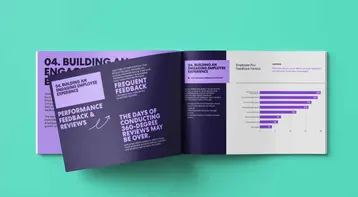Employee Benefits Communication: Best Practices for Small Businesses

Table of contents
- 1.What is Employee Benefits Communication?
- 2.The Importance of Communicating Benefits to Your Workforce
- 3.Boost Overall Employee Experience
- 4.Increase Employee Satisfaction and Retention
- 5.Elevate Employee Engagement Levels
- 6.Comply with Benefits-related Requirements
- 7.Best Practices to Communicate Employee Benefits
- 8.Use Employee Onboarding to Demonstrate How to Use Benefits
- 9.Explain the Benefits Package in Clear, Simple Language
- 10.Create an Effective Benefits Communication Plan for Managers
- 11.Keep the Conversation Open
- 12.Personalize Your Benefits Communication Plan
- 13.Allow Multiple Formats of Communication to Occur
- 14.Provide Examples and Visual Aids
- 15.Reinforce Accessible Communication Channels
- 16.Integrate Communication Into Other Strategies
- 17.Get Employee Feedback
- 18.Regularly Review and Revise
Although creating a strong benefits package is important, employees who don't understand the value of their benefits may not use them to their full extent. In fact, nearly half of employees today don't understand their benefits. This can increase workplace stress and cause strain on productivity, which is why communication is key. To help ensure your company's benefits are well understood, here's what you need to know about building an employee benefits communication strategy.
What is Employee Benefits Communication?
Employee benefits communication is sharing and explaining the information about your company's benefit offerings. This includes everything available to your team, from traditional health insurance, retirement plans, wellness programs and any other non-traditional perks included in their employment package. Effective communication helps employees be fully aware of their benefits and how to access benefits administration software. This allows them to better understand how to utilize benefits while recognizing the value they add to their overall employment experience.
The Importance of Communicating Benefits to Your Workforce
76% of employees who understand their benefits are happy, and 82% said that understanding them would help increase their sense of stability. Moreover, 50% said understanding their benefits more would increase their loyalty to their employer. Therefore, creating an effective employee benefits communication strategy can offer several advantages to your company's bottom line. Some of the most notable include the following:
Boost Overall Employee Experience
Explaining employee benefits can also significantly enhance the overall employee experience. When well-informed about their benefits, employees can make better decisions that positively impact their well-being and job satisfaction. This understanding helps employees feel more valued and appreciated, fostering a positive work environment.
Increase Employee Satisfaction and Retention
Strong communication can also lead to increased employee satisfaction and retention. When employees fully understand and appreciate the benefits offered to them, they’re more likely to feel content and remain loyal to the company. This helps to reduce turnover and the associated costs of hiring and training new employees. Additionally, satisfied employees are more likely to act as ambassadors for your company, promoting it as a great workplace.
Elevate Employee Engagement Levels
Employee satisfaction and engagement go hand in hand, and those who are more engaged tend to be more productive and committed to their positions. Taking the time to communicate benefits effectively helps employees feel supported and valued, which may help elevate engagement.
Comply with Benefits-related Requirements
Effective benefits communication also helps you stay compliant with benefits-related requirements. This not only helps to mitigate potential issues but also fosters a transparent and trustworthy relationship with your workforce.
Best Practices to Communicate Employee Benefits
Here are some of the best ways to help employees understand their benefits throughout the year.
Use Employee Onboarding to Demonstrate How to Use Benefits
The onboarding process is one of the best times to educate new employees about their benefits. Detailed information, including how to take advantage of benefits they are eligible for, can be integrated into your onboarding strategy so new employees have the resources to start strong. A great option for this is including a checklist with enrollment deadlines so employees can work their way through signing up for the benefits they'd like to utilize. During or after onboarding, have a manager or supervisor review the checklist during a one-on-one meeting to provide clarification as needed.
Explain the Benefits Package in Clear, Simple Language
The effectiveness of your communication strategy can be maximized by using clear, simple language so that all employees, regardless of their background or familiarity with benefits, understand what's being offered. Benefit plans can be explained without complex jargon or confusing sentences, so do what you can to demystify any complicated information so that it's more accessible to everyone.
Create an Effective Benefits Communication Plan for Managers
Leaders and managers can play a role in communicating benefits information to their teams. They directly affect employee awareness and can make open and ongoing communication much more accessible in growing SMBs. Work with your leadership teams to equip managers with the knowledge and tools to direct their employees how to obtain information about your company’s benefit offerings. Regular training sessions and updates for managers can keep them informed about enrollment periods and any changes or new offerings in the benefits package.
Keep the Conversation Open
Allowing staff to access their benefits or talk to someone about them easily is another key part of successful benefits communication. Your workforce should be able to find the information they need or connect with someone to help them learn how to use their benefits regardless of how long they've been at the company. Open communication also allows employees to voice their concerns and preferences, fostering a more inclusive and responsive benefits program.
Personalize Your Benefits Communication Plan
Employees have different needs and preferences, so it's important to respect that when it comes to communication efforts. Consider tailoring messages and resources to specific employee segments, such as by department, age group or job role. Personalized communication increases the likelihood that each employee receives relevant information that resonates with their unique circumstances.
Allow Multiple Formats of Communication to Occur
While one employee may be able to understand the benefits available to them through a printed document, another may benefit from a webinar. Everyone has different learning styles and ways of processing information, so small businesses can help maximize communication efforts by offering explanations or resources across various channels. These can include things like company-wide emails, newsletters, optional webinars, in-person meetings with HR experts or an online benefits portal. This way, all employees can access information in a way that suits them best.
Provide Examples and Visual Aids
Visual aids such as infographics, charts and videos can make benefits information more engaging and easier to understand. Consider using these tools to illustrate complex information and provide clear examples of how benefits can be used. This also increases inclusivity for individuals who may have more visual learning styles.
Reinforce Accessible Communication Channels
Once you have your communication channels defined and resources in place, make sure that all of your employees know where to find the information when they need it. Improving accessibility could mean creating an online portal, a dedicated section on the company’s employee website or a regularly updated benefits booklet. However, remember that a traditional handbook might not be viewed as often as an online portal in the same way search engines made phonebooks obsolete.
At the end of the day, convenience and accessibility is key to effective communication. Regularly remind employees of these resources and confirm they are easy to navigate and up-to-date.
Integrate Communication Into Other Strategies
You can also integrate benefits communication into broader employee engagement and development strategies. This helps to ensure that benefits are considered an integral part of the overall employee experience and not just an afterthought. Aligning benefits communication with other HR initiatives, such as performance reviews and professional development programs, reinforces their importance and relevance.
Get Employee Feedback
A strong communication strategy helps improve engagement with benefits, but you need to check that it's effective for employees. To do this, seek employee feedback on the effectiveness of your benefits communication. This can help you identify areas for improvement and confirm that your communication strategies meet your workforce's needs. Conduct surveys, focus groups and one-on-one check-ins to see what's working and what adjustments need to be made to your communication plan.
Regularly Review and Revise
Some benefits will naturally change or evolve as the year progresses, and it's important to boost employee awareness of these changes as they occur. Therefore, a year-round communication plan should be in place as a proactive approach to benefits.
You may also find that, based on employee participation, some benefits aren't being utilized. This can allow you to refine your employee benefits package to reflect the needs of your workforce. For example, maybe your team isn't using some of the wellness benefits you offer but has expressed interest in mental health benefits. If the cost of benefits aligns with your company’s financial goals and strategic priorities, making changes may help further boost employee retention and engagement.
Working with an HR professional can help you assess your current benefits and make sustainable changes that improve employee satisfaction. To get access to and the most out of big-company benefits as an SMB, work with a professional employer organization (PEO) like TriNet. TriNet provides SMBs access to traditional healthcare benefits alongside a variety of non-traditional benefits that are cost-effective, as well as effective solutions for managing employee benefits. Learn more about how TriNet can enhance your benefit programs today.
This article is for informational purposes only, is not legal, tax or accounting advice, and is not an offer to sell, buy or procure insurance. It may contain links to third-party sites or information for reference only. Inclusion does not imply TriNet’s endorsement of or responsibility for third-party content.
TriNet Team
Table of contents
- 1.What is Employee Benefits Communication?
- 2.The Importance of Communicating Benefits to Your Workforce
- 3.Boost Overall Employee Experience
- 4.Increase Employee Satisfaction and Retention
- 5.Elevate Employee Engagement Levels
- 6.Comply with Benefits-related Requirements
- 7.Best Practices to Communicate Employee Benefits
- 8.Use Employee Onboarding to Demonstrate How to Use Benefits
- 9.Explain the Benefits Package in Clear, Simple Language
- 10.Create an Effective Benefits Communication Plan for Managers
- 11.Keep the Conversation Open
- 12.Personalize Your Benefits Communication Plan
- 13.Allow Multiple Formats of Communication to Occur
- 14.Provide Examples and Visual Aids
- 15.Reinforce Accessible Communication Channels
- 16.Integrate Communication Into Other Strategies
- 17.Get Employee Feedback
- 18.Regularly Review and Revise






